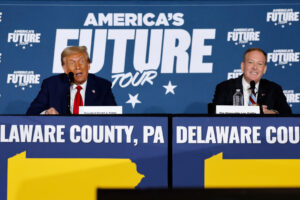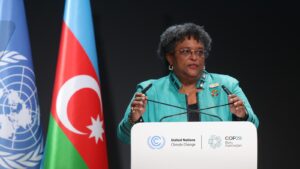When the crates with the fossilized bones of Victoria the T rex arrived Melbourne Museum, one of Australia’s leading palaeontologists, was giddy with excitement – and trepidation.
“This is the closest I’ve ever come to the skull of a T rex,” says Dr Erich Fitzgerald.
“It’s all at once the stuff of dreams for a lifelong dinosaur nut and it’s also downright terrifying.”
Victoria, named after the Canadian city, is 66m years old and one of the most complete and well-preserved Tyrannosaurus rex fossils on the planet.
The 199 bones – including the massive, nearly perfect skull – make up more than half of the animal’s original skeleton.
“We rarely have more than about 10 to 15%,” says Fitzgerald.
“So to have anywhere between 50 and 70% of the skeleton made up of the original fossil bones is extraordinary.”
However, the skull that will adorn the 12-metre-long skeleton will be a recreation, with the actual 139kg fossil to be displayed in a separate display window.
Fitzgerald faced the painstaking task of bringing the dinosaur back to life bone by bone.
“The bones of the skull of Victoria are both very heavy and very fragile. So… sit down [it] almost four meters up in the air, while sitting on some steel brackets, there are some risks involved,” says Fitzgerald.
“But also having the real fossil bones down … is in some ways an even more exciting experience. Because you’re getting that close to a skull the size of a refrigerator. And that’s something we generally can’t do in our everyday lives.”
Victoria was discovered in South Dakota in 2013, but it took years of “hard work” to extract the bones from the rock, ensure they were structurally sound and determine which bones were which.
“Sometimes you have a big bit or a little bit of bone that you know should belong somewhere in the skeleton [and] you have to work out where that puzzle piece goes,” says Fitzgerald.
Getting the precious bones from Victoria to Melbourne was no easy feat either, as they arrived at the Melbourne Museum in no fewer than 14 custom foam-molded and highly cushioned crates.
“There’s always going to be a bit of a thought when you open that box after it’s traveled thousands of miles, ‘Oh, how did it go this time,'” Fitzgerald said, grimacing at the memory.
After being fork-lifted into the exhibition hall, the bones were then painstakingly unpacked by the museum’s paleontologists and conservators.
The skeleton construction alone took a team of four people a week to build, using scissor lifts to reassemble the fossil body and secure it to the 40-foot steel anchor.
“The bones of Victoria are maintained … in climate control situations, and especially with control of humanity in mind,” Fitzgerald said.
“So Victoria’s legs get very royal treatment fit for the king or queen of dinosaurs.”







